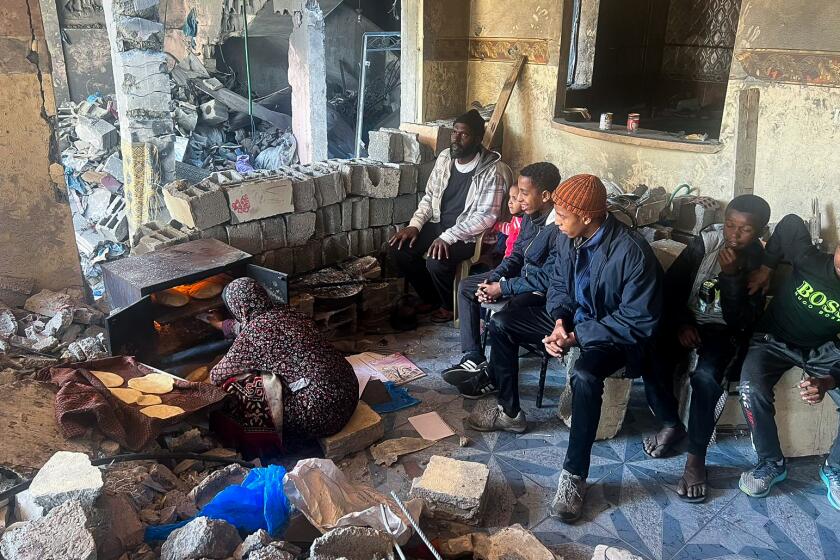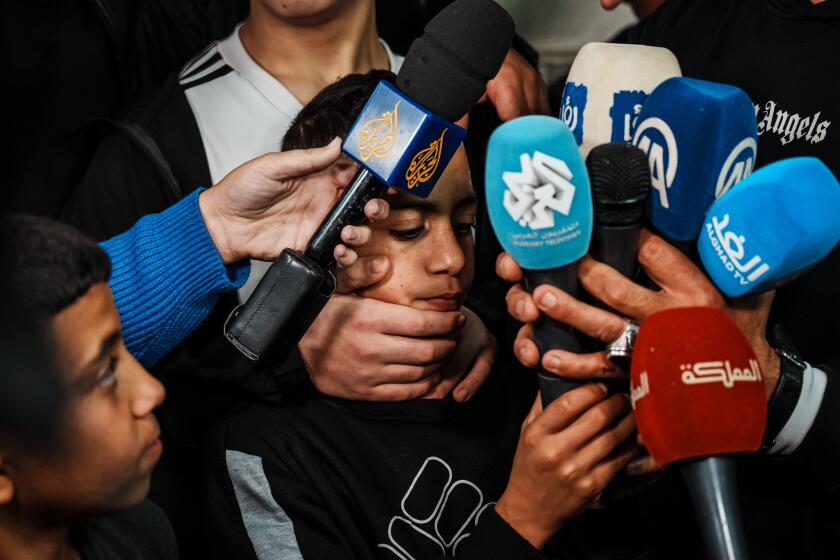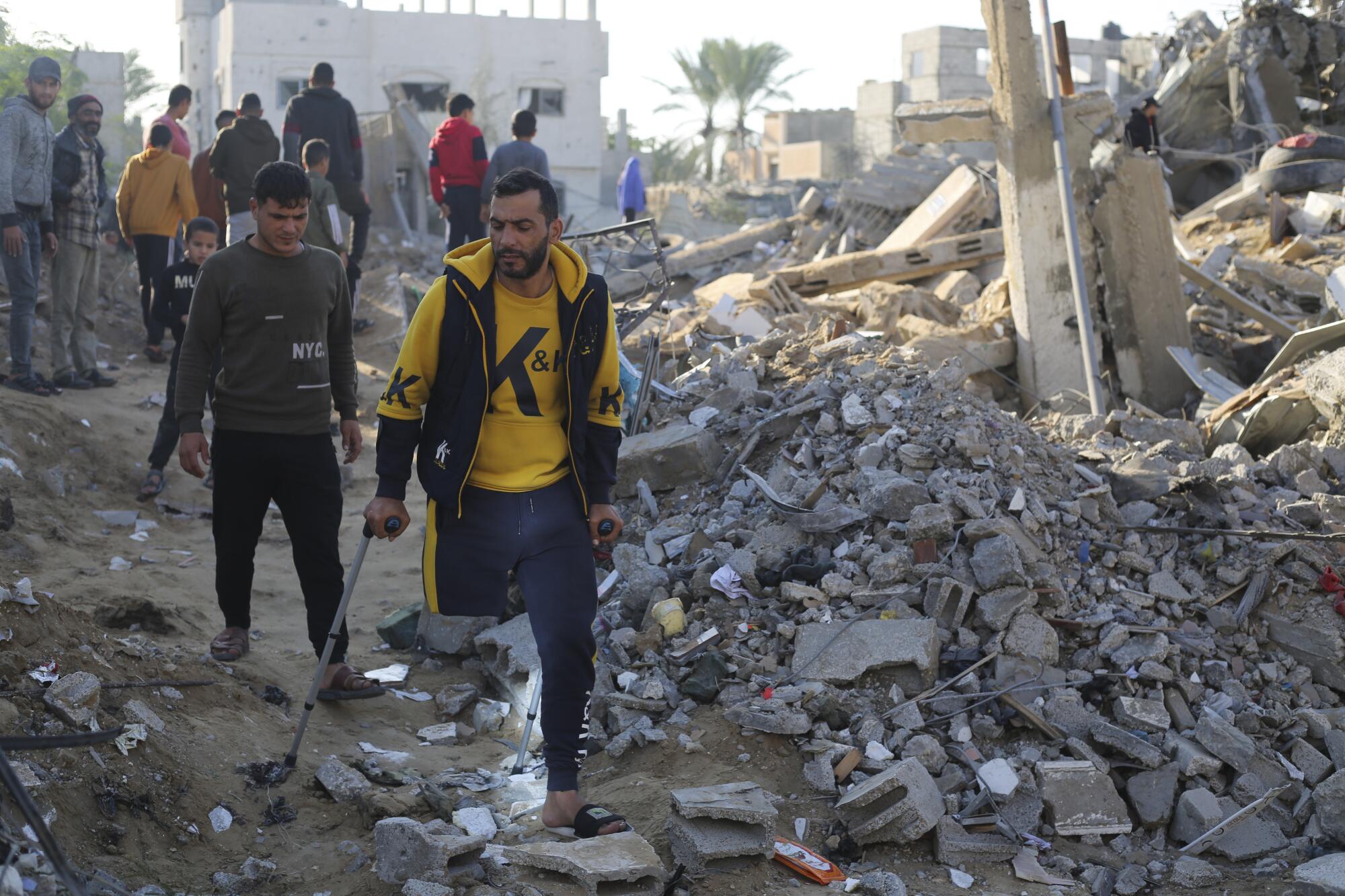
- Share via
DEIR AL BALAH, Gaza Strip — Israeli warplanes heavily bombarded an area around Khan Yunis in southern Gaza on Monday as the military ordered mass evacuations from the town in the face of a widening ground war that is pushing Palestinians into progressively tinier slivers of the besieged territory.
The expanded assault posed a deadly choice for hundreds of thousands of Palestinians: Either stay in the path of Israeli forces or flee within the confines of southern Gaza, with no guarantee of safety. Aid workers warned that the mass movement would worsen the already-dire humanitarian catastrophe in the territory.
“Another wave of displacement is underway, and the humanitarian situation worsens by the hour,” Thomas White, the Gaza chief of the United Nations agency for Palestinian refugees, said in a post on the platform X, formerly known as Twitter.
Adding to the chaos, phone and internet networks across Gaza collapsed again Monday evening, the Palestinian telecom provider PalTel reported. The network has broken down multiple times during the war, making it largely impossible for residents to communicate with each other or the outside world for hours or sometimes several days until it is repaired.
Israel has vowed to eliminate Gaza’s Hamas rulers, whose Oct. 7 attack on Israel triggered the deadliest Israeli-Palestinian violence in decades. The war has already killed thousands of Palestinians and displaced more than three-fourths of the territory’s population of 2.3 million people. Palestinian health officials say the bombardment has killed several hundred civilians since a weeklong truce ended Friday.
‘I just don’t know where we’ll go.’ It’s a question Palestinians ask over and over in Gaza as Israel ramps up bombardment after Hamas truce collapsed.
Already under mounting pressure from its top ally, the U.S., Israel appears to be racing to strike a death blow against Hamas — if that’s possible, given the group’s deep roots in Palestinian society — before any new cease-fire. But the mounting toll is likely to further increase international pressure to return to the negotiating table.
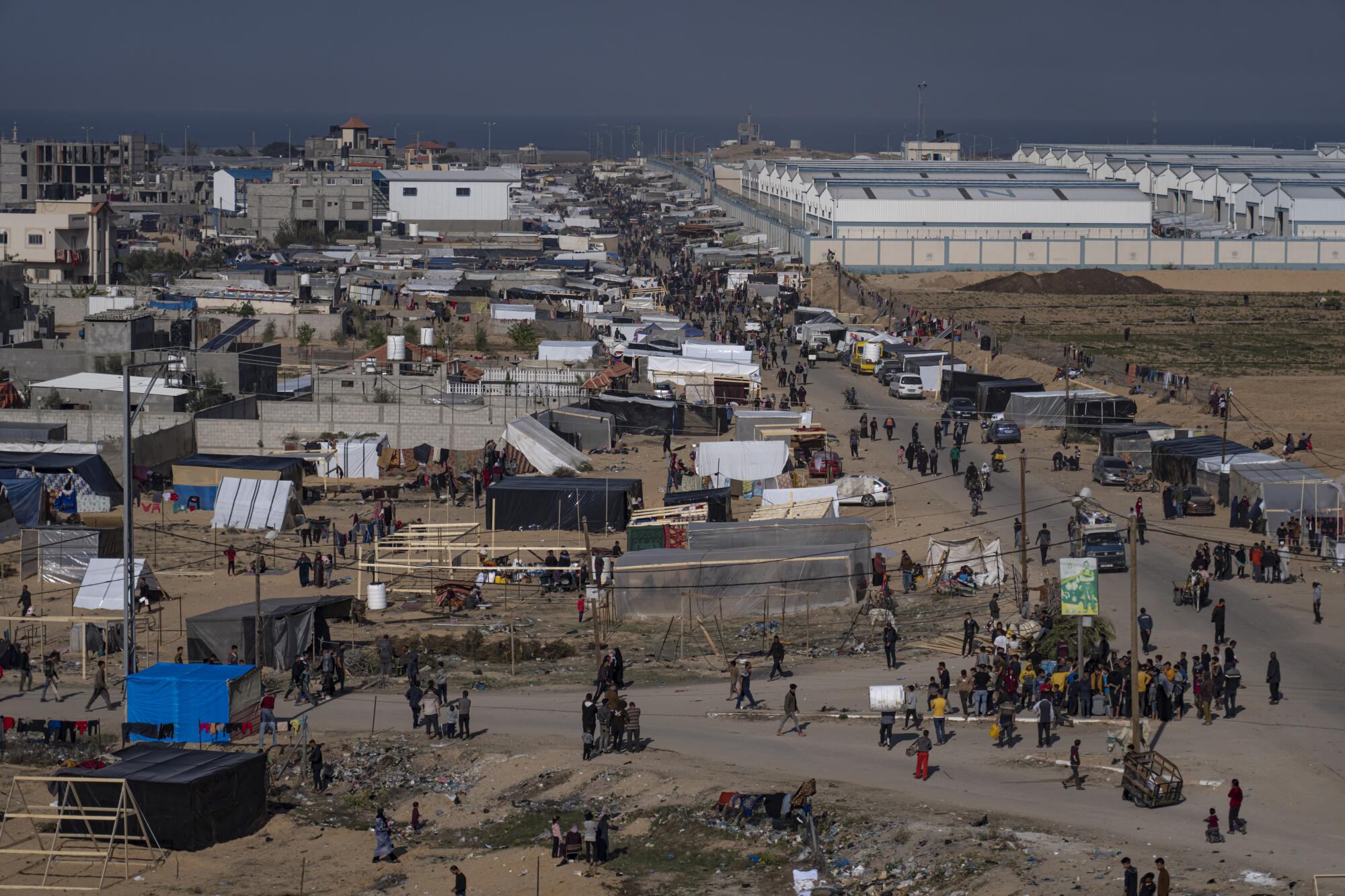
Airstrikes and ground assaults in northern Gaza have reduced large swaths of Gaza City and nearby areas to a rubble-filled wasteland. Hundreds of thousands of residents fled south during the assault.
Now, around 2 million people — most of the territory’s population — are crowded into the 90 square miles of southern and central Gaza, where Israel is expanding its attacks, threatening to render even larger areas uninhabitable.
Residents said Monday that they heard airstrikes and explosions in and around Khan Yunis overnight after the Israeli military dropped leaflets warning people to relocate farther south toward the border with Egypt.
Since the truce’s collapse, the military has ordered the population out of an area of about 24 square miles in and near Khan Yunis, according to the evacuation maps issued by the Israeli military. That further reduces the space available for Palestinians by more than a quarter.
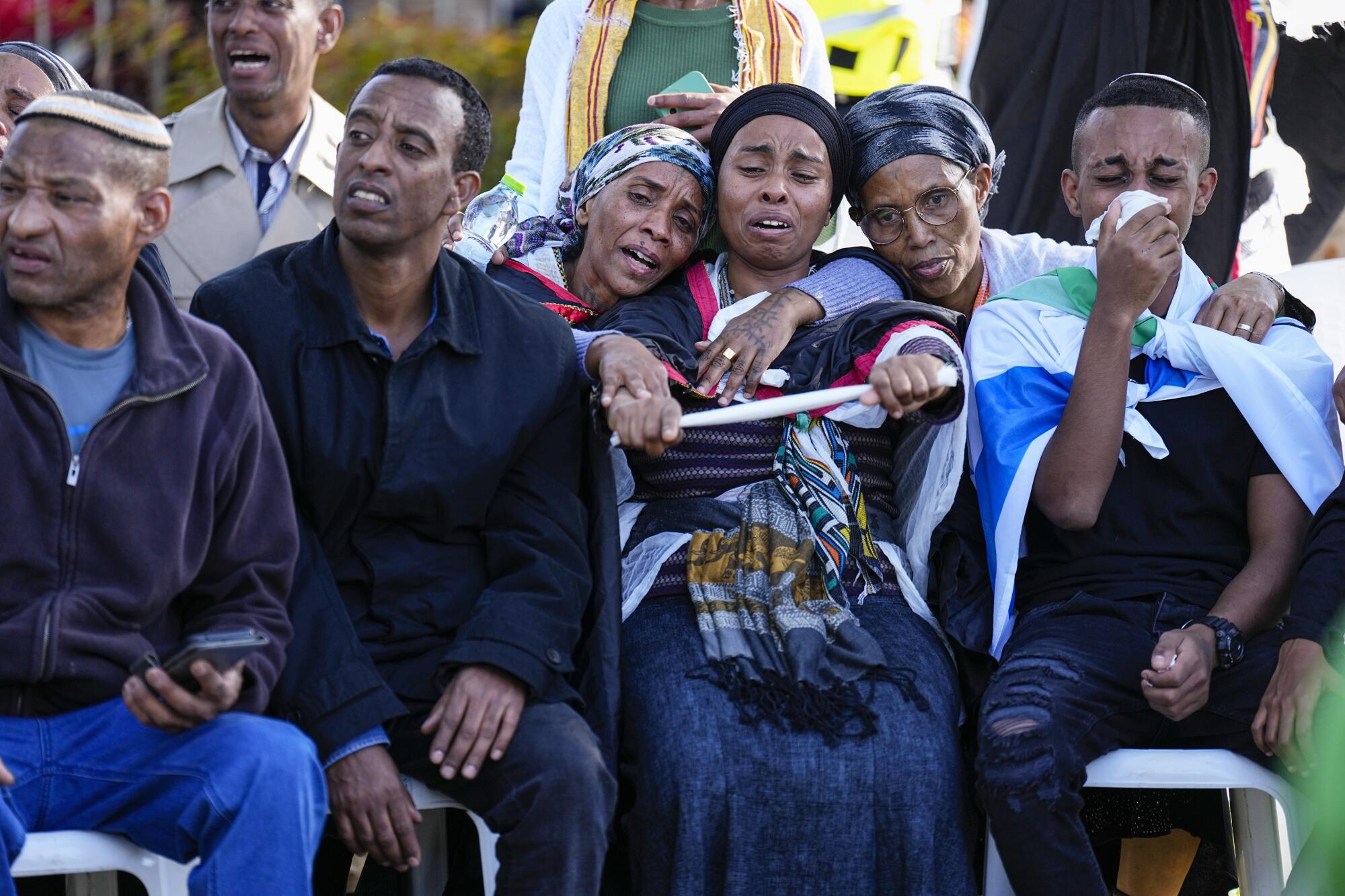
Constant bombardment on the edges of Khan Yunis, Gaza’s second-largest city, lit up the sky over the town Monday evening, and a stream of ambulances carrying wounded, including several women and children, flowed into the main hospital.
Over the last few days, Israeli strikes have been “on a ferocious scale,” said Mohammed Aghaalkurdi, an aid worker with the group Medical Aid for Palestinians in Khan Yunis. “Barely has any kind of aid been delivered to the people, nor is there any food left in shops.”
He said neighborhoods and displaced shelters were emptying as people fled. Leaflets dropped by the military warn people to go south toward the border with Egypt, but they are unable to leave Gaza.
The area that Israel ordered evacuated covers about a fifth of Khan Yunis. Before the war, that area was home to some 117,000 people, and now it also houses more than 50,000 people displaced from the north, living in 21 shelters, the United Nations said.
It was not known how many were fleeing. Some Palestinians have ignored past evacuation orders, saying they do not feel any safer since areas where they are told to flee have also been bombed. Many also fear they will never be allowed back to their homes.
It was not clear where Israeli troops have moved into southern Gaza, but the military told people to stay off the main road between Khan Yunis and Deir al Balah, suggesting forces were moving between the two towns.
Israeli media also reported intense fighting between Israeli troops and Hamas militants in northern Gaza — in the Jabaliya refugee camp and the Gaza City district of Shijaiya, both scenes of intense bombardment and battles in recent weeks.
Families of Israeli hostages being held by Hamas in Gaza are appealing for the safe return of their loved ones in visits to Los Angeles and other stops in their global campaign.
Rear Adm. Daniel Hagari, an Israeli military spokesman, said that the army was pursuing Hamas with “maximum force” in the north and south and that it was trying to minimize harm to civilians.
He pointed to a map that divides southern Gaza into dozens of blocks in order to give “precise instructions” to residents on where to evacuate. Most are urged to flee south, but, confusingly, a map posted on X by the military Monday urged people to flee into Fakhari, a district east of Khan Yunis that the military ordered evacuated a day before.
“The level of human suffering is intolerable,” Mirjana Spoljaric, the president of the International Committee of the Red Cross, said during a rare visit to Gaza. “It is unacceptable that civilians have no safe place to go in Gaza, and with a military siege in place there is also no adequate humanitarian response currently possible.”
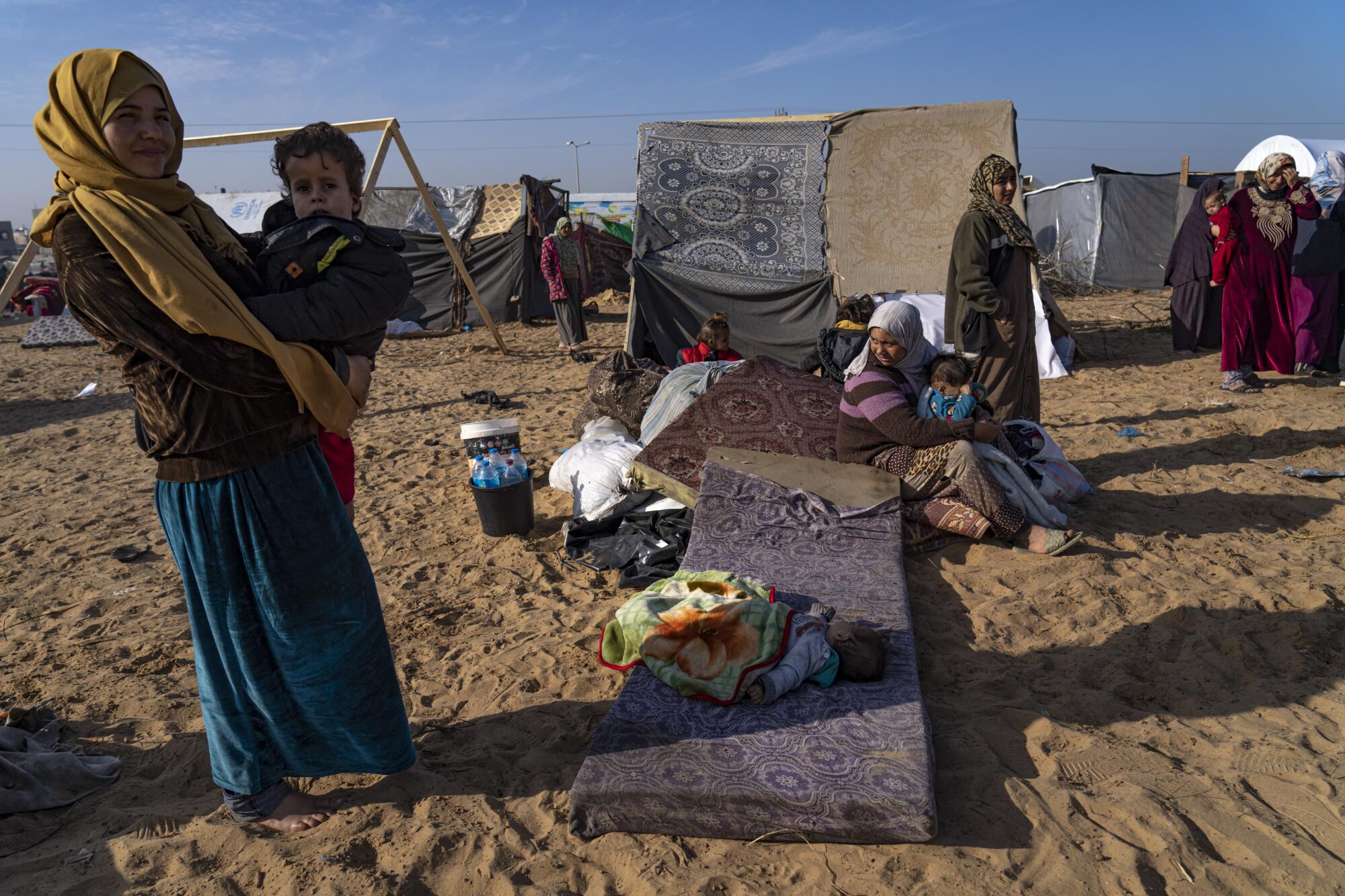
She also called for the immediate release of scores of hostages captured by Palestinian militants during the Oct. 7 attack.
In a letter to the Red Cross chief, a group of released Israeli hostages asked to meet her while she is visiting the region and called for more help from the organization to free the remaining 137 captives.
“Every day that passes could be their last, and the suffering they endure is inhuman,” wrote the eight freed captives and 102 relatives of hostages still in captivity.
The Health Ministry in Hamas-run Gaza said the death toll in the territory since Oct. 7 has surpassed 15,890, with more than 42,000 wounded. The ministry does not differentiate between civilian and combatant deaths, but said 70% of the dead were women and children.
Health Ministry spokesman Ashraf Qidra said hundreds have been killed or wounded since the cease-fire’s end, with many still trapped under rubble.
The Aqsa Martyrs Hospital in Deir al Balah received 32 bodies overnight after Israeli strikes across central Gaza, said Omar Darawi, an administrative employee. Associated Press video showed women in tears, kneeling over the bodies of loved ones and kissing them.
The recent hostage-for-prisoner swaps between Hamas and Israel have focused attention on the number of Palestinian minors imprisoned by Israel.
The Israeli military said without elaborating that aircraft had struck some 200 Hamas targets overnight, with ground troops operating “in parallel.” It said troops in northern Gaza had uncovered a militant hideout in a school after coming under attack. Inside, they found two tunnel shafts, one of which had been booby-trapped, as well as explosives and weapons, the military said.
It is not possible to independently confirm battlefield reports from either side.
Israel says it targets Hamas operatives, not civilians, and blames civilian casualties on the militants, accusing them of operating in residential neighborhoods. It does not provide an accounting of its targets in individual strikes.

Israel claims to have killed thousands of militants, without providing evidence. Israel says at least 81 of its soldiers have been killed.
The U.S. is pressing Israel to avoid more mass displacements and the killing of civilians, a message underscored by Vice President Kamala Harris during a visit to the region. She also said the U.S. would not allow the forced relocation of Palestinians out of Gaza or the occupied West Bank, or the redrawing of Gaza’s borders.
If Gazans are forced into Egypt or elsewhere, they will only add to the 75-year-old Palestinian refugee crisis.
But it’s unclear how far the Biden administration is willing or able to go in pressing Israel to rein in the offensive, even as the White House faces growing pressure from its allies in Congress.
The U.S. has pledged unwavering support for Israel, including by sending munitions and other aid, since the Oct. 7 attack. Israel says the Hamas assault killed more than 1,200 people, mostly civilians.
Israel has rejected U.S. suggestions that control over postwar Gaza be handed over to the internationally recognized Palestinian Authority as part of renewed efforts to resolve the overall conflict by establishing a Palestinian state.
More to Read
Sign up for Essential California
The most important California stories and recommendations in your inbox every morning.
You may occasionally receive promotional content from the Los Angeles Times.
